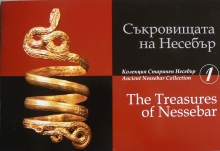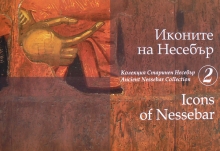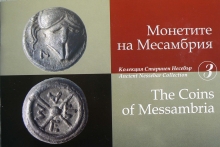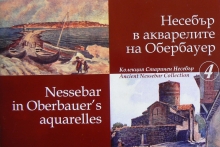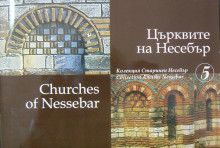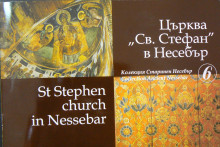


| MUSEUM PUBLICATION |
|||
|---|---|---|---|
| A Guide to the collections of the Archaeological museum of Nessebar. Petya Kiyashkina, Anelia Bozkova, Todor Marvakov. Published for the Archaeological Museum of Nessebar by Vessela Publisher, Nessebar, 2012, 192 p. | |||
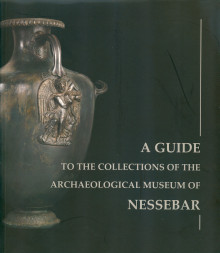 A detailed guide-book to the Archaeological Museum of Nessebar came out of print in English. It is addressed to the numerous visitors of the museum town, included in UNESCO’s World Heritage List as a cultural monument with exceptional value. The publication was financed by “Leventis” Foundation, which, over the past years, generously supports the restoration and conservation of Nessebar’s most prominent landmarks. The authors of „A Guide to the collections of the Archaeological museum of Nessebar” are: Petya Kiyashkina (Ancient Nessebar Museum), Associate Professor Aneliya Bozhkova (National Archaeological Institute) and Todor Marvakov (Ancient Nessebar Museum). The photographs were made by Dragomir Ushev, and the Bulgarian to English translation was realized by Associate Professor Peter Delev (lecturer at the University of Sophia). The guide was prepared for publishing by „Vessela Publishers” in Plovdiv and it was printed by “Poligraph Commerce”. The first part is named “A promenade through time. The history of the Museum in Nessebar and of the archaeological investigations in the city”. It is written by Petya Kiyashkina who focuses on the establishment and the development of the museum during the second half of the 20th and the first decade of the 21st centuries. She also follows the chronology of all archaeological and historical studies on the territory of the Old town from the 18th century till present. Associate Professor Anelia Bozhkova emphasizes the museum’s collections and explains their initial formation according to their types and characteristics, and also their designations in the different halls in the museum. The catalogue is arranged chronologically and according to the types of the artifacts. With synthesized explanations and splendid photographs the authors present us to painted vessels, sculptures, reliefs, refined terracotta, exquisite jewelry, as well as to gorgeous architectural decorations from old Mesambrian temples and houses. Some of the artifacts are published for a first time here. The only place the guide-book can be purchased is the Archaeological Museum of Nessebar. |
|||
| Nessebre, III. Authors: Luba Ognenova-Marinova, Maria Reho, Jeanna Cimbuleva, Dimitar Sasselov, Velizar Velkov, Ivan Karayotov, SPRING LTD, Burgas, 2005, 228 p. | |||
 The third volume of serial edition “Nessebar” appears with delay of almost 20 years. It includes an article of senior research associate Luba Ognenova- Marinova for the residential architecture of ancient Messembria. The research associate Maria Reho makes a complete review of attic pottery, found between the remains of ancient town and its necropolis. Important contribution in the research of Nessebar’s fortification system creates architect Dimitar Sasselov, explaining from many sides the condition of southern fortification wall. A large “corpus” of Messambria’ inscriptions belong to prof. Velkov. A research of Messambria’s circulation of bronze coins from prof. Karayotov helps us to feel the economic power of Hellenistic Messambria. The deceased Jeanna Cimbuleva is author of two articles in Nessebar, volume III. The edition is dedicated to her memory. |
|||
| Bulgaria Pontica Medii Aevi, IV-V2 . Publisher Vassil Gyuzelev. PH “Gutenberg”, Sofia, 2006, 464 p. | |||
 Historical and summary reports, read on the fourth and fifth International symposiums „Bulgaria Pontica Medii Aevi”are published in the volume. The authors here are remarkable medievalists from different countries, all of them with an enormous contribution for the world and Black Sea history of shipping, sea trade and oversea cultural contacts. The first report belongs to deceased German professor Johannes Irmscher. In brief form Irmscher formulates exceptionally important problems for historical science, hidden in the expression Bulgaria Pontica Medii Aevi. He gives a good evaluation of organizers and participants in the symposium, underlining their great contribution for the sea history of Byzantium, Medieval Bulgaria and Italian republics. Jeanna Cimbuleva publishes for the first time a rich collection of architectural marble monuments, discovered in Obzor, the ancient Templum Yovis. A rich source material is interpreted by the permanent participants in the Symposium Geo Pistarino, Laura Balletto and Enrico Basso (Genua), FrancoRossi (Venice), P. Karpov and Valentina Shandrovskaya( Saint Petersburg), Nikolas Oikonomides( Athens), Gyorgy Szekely ((Budapest), Svetlana Blizniuk and Pustam Shukurov (Moskow) etc. |
|||
| Rashenov, Architect Dr Alexender. Churches of Messambria. Eglises de Messembria. Phototype edition - bilingual, Bulgarian and French. Editor Ivan Karayotov, PH “Ritam-3”LTD, Nessebar 2006, 216 p. | |||
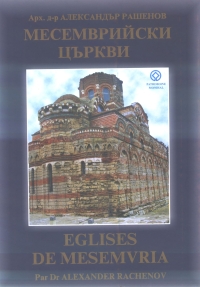 Architect Alexender Rashenov’s book was published in the remote 1932 and it became a bibliographical rarity a long time ago. At the same time, the book remains even nowadays the most complete research for the medieval churches of Messembria and It is a highly esteemed reference book for all people interested in medieval architecture, history and culture. “Ancient Nessebar”museum undertook its republication as a phototype edition. A biographic article of Rashenov from Petya Kiyashkina is added to the original pages of the first edition, as well contemporary coloured pictures of churches, object of the book and a modern architectural analysis of Nessebar’s polychrome architecture from architect Dimitar Sasselov. |
|||
| Bulgaria Pontica Medii Aevi VI-VII, Mesemvria Pontica, International seminar Nessebar, 28-31 May 2006. Studia in honorem professoris Vasil Guzelev, Editionem curavit Ivan Karayotov, Burgas, 2008. | |||
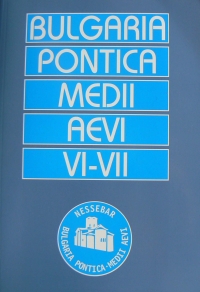 The edition, where are published reports, read on the international seminar„Mesemvria Pontica”, took in Nessebar trough 2006 is dedicated to the seventieth anniversary of academician professor Vasil Gyuzelev. In the first part of the volume are published the nine reports, concerning classical archaeology and numismatics. Prof. Henrieta Todorova dedicated her study to the cave temple of great Mother of Gods, discovered by her team in Duranculak. Black varnished ceramic, found in Odessos is a topic of Anelia Bozkova from National archaeological Institute and Hristo Preshlenov studies the changes of the coast strip of Nessebar peninsula during the ages. Prof. Evgeni Molev ( Nijni Novgorod) gets us to know the last archaeological excavations in the antic city Kyta on the north Black Sea. Prof. Manfred Opperman makes important analogies of terracotta from ancient Messembria. Sergey Vnukov (Moscow) presents us the amphora tare in the Western Black Sea region. “Kabiri and the sea” is the theme of prof. Ivan Marazov. Prof. Karayotov makes interesting historical conclusions on the basis of coinage in Messembria. In the section “Western Black Sea region, Mediterranean lands and Medieval Nessebar” participate thirteen famous scientists. Here are the articles of prof. Vasilka Tapkova- Zaimova, prof. Elka Bakalova, prof. Mark Kramarovski( Saint Petersburg), prof. Peter Schreiner (Koln), prof. Sandra Origone ( Genua), prof. Oliver Schmitt (Vienna), prof. Massimiliano David ( Bologna), architect Dimitar Saselov and Iva Doceva. The reports of Boyan Beshevliev and Dimitar Dimitrov are directly connected with the sea history. The first scientist analyses the first outline of Nessebar peninsula and Nessebar from Karl Vincke and Helmuth Moltke ant the second one studies Nessebar harbour in the Middle Ages. The volume ends with a bibliography of Vasil Guzelev, studies for Nessebar, Black sea and Mediterranean coasts. This is a work of Georgy Nikolov. |
|||
| “Ancient Nessebar collection” serial edition | |||
|
“Ancient Nessebar” museum undertakes the print of special serial edition of colour booklets, devoted to its rich collections of archaeological monuments and coins. The first four albums are at reader’s disposal.
The first album is devoted to the magnificent gold jewellery, found in the Necropolis of Hellenistic Messembria. These are spiral rings, necklaces, agraffes and earrings. Medieval adornments and characteristic bracelets and earrings from 16-17 c. are included in the album too. The second booklet shows the most characteristic icons of Nessebar. They are dated back to 13- 18 c. and their typical style with the names of the authors proves the existence of local icon school. The school is a successor of rich medieval traditions and proves that even in this period Nessebar continues to be unattainable pearl of Orthodoxy.
The third album represents the ancient Messembria coinage. All Messambrian silver and bronze coin types from 5th c. BC until third c. AD are represented. This edition shows to readers the basic images on the Messembrian coins: faced and half-faced casque, wheel with spokes, Amazon shield, Athena Alkidemos and other gods. The fourth booklet shows us Nessebar in the first half of 20eth century painted by the aquarellist J. Oberbauer. We can see how churches of Nessebar, isthmus, the city gate looked like in this remote past. The former windmills are not omitted, spreading sails above the peninsula and sea waves. Two more booklets enriched the “Ancient Nessebar Collection” in 2010.
Booklet № 5 is titled “The Churches of Nessebar” and encompasses all of the churches in the Old town preserved to this day – the basilicas of Hagia Sophia and The Holy Virgin Eleousa, the churches from the 10th – 11th century St John the Baptist and St Stephen, as well as the picturesque churches dating to the 13th –14th century - St Theodor, St Paraskeva, Saints Archangels Michael and Gabriel, Christ Pantocrator and St John Aliturgetos. Each one of the churches is presented in a concise form, with photos, an architectural plan and a short text. Booklet № 6 is entirely dedicated to St Stephen church and emphasizes its unique mural paintings, dated to the 16th century. These magnificent paintings distinguish the church as one of the most significant monuments of the Bulgarian cultural heritage. |
|||
